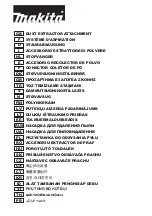
9
ENGLISH en
Original instructions
On our own responsibility, we hereby declare that
this drilling and chisel hammer, identified by type
and serial number *1), meets all relevant
requirements of directives *2) and standards *3).
Technical documents for *4) - see page 3.
MHEV...:2000/14/EC: Conformity assessment
procedures in accordance with Annex VI (m < 15
kg). (Testing agency: Slovenian Institute of Quality
and Metrology, Trzaska cesta 2, SI-1000 Ljubljana,
Slovenia (Notified Body No.: 1304)).
The combination hammer (KHEV...) is designed for
hammer drilling and chiselling in concrete, bricks,
stone and similar materials when used in
combination with appropriate accessories.
The chisel hammer (MHEV...) is designed for
chiselling in concrete, bricks, stone and similar
materials when used in combination with
appropriate accessories.
The user bears sole responsibility for any damage
caused by inappropriate use.
Generally accepted accident prevention
regulations and the enclosed safety information
must be observed.
For your own protection and for the
protection of your power tool, pay
attention to all parts of the text that are
marked with this symbol!
WARNING – Read the operating
instructions to reduce the risk of injury.
WARNING Read all safety warnings and
instructions.
Failure to follow all safety
warnings and instructions may result in electric
shock, fire and/or serious injury.
Keep all safety instructions and information for
future reference.
Always include these documents when passing on
your power tool.
Wear ear protectors. Exposure to noise can
cause hearing loss.
Use auxiliary handle(s), if supplied with the
tool. Loss of control can cause personal injury.
Hold power tools by insulated gripping
surfaces when performing an operation where
the cutting tool may contact hidden wiring or
its own cord. Contact with a live wire will make
exposed metal parts of the tool live and shock the
operator.
Pull the plug out of the socket before making any
adjustments, changing tools, carrying out
maintenance or cleaning.
Always work with the additional handle correctly
installed.
Always hold the machine with both hands on the
intended handles, take a secure stance and
concentrate on the work.
Always wear protective goggles, gloves, a dust
mask and sturdy shoes when working with this tool.
Ensure that the place where you wish to work is free
of power cables, gas lines or water pipes (e.g.
check using a metal detector).
Work only with a correctly fitted tool. Pull on the tool
to check that it is correctly seated. (It must be
possible to move the tool a few centimetres in an
axial direction.)
When working above ground level, ensure that the
area below you is clear.
Never touch the tool or parts near the tool directly
after work because they may be extremely hot and
can cause burns to the skin,
Always position the power cable so that it leads
away from the back of the machine.
A damaged or cracked additional handle must be
replaced. Never operate a machine with a defective
additional handle.
Secure the workpiece to prevent slipping or rotation
(e.g. by securing with screw clamps).
Reducing dust exposure:
WARNING - Some dust created by power
sanding, sawing, grinding, drilling, and other
construction activities contains chemicals known to
cause cancer, birth defects or other reproductive
harm. Some examples of these chemicals are:
- Lead from lead-based paints,
- Crystalline silica from bricks and cement and
other masonry products, and
- Arsenic and chromium from chemically treated
lumber.
Your risk from these exposures varies, depending
on how often you do this type of work. To reduce
your exposure to these chemicals: work in a well-
ventilated area, and work with approved safety
equipment, such as those dust masks that are
specially designed to filter out microscopic
particles.
This also applies to dust from other materials such
as some timber types (like oak or beech dust),
metals, asbestos. Other known diseases are e.g.
allergic reactions, respiratory diseases. Do not let
dust enter the body.
Observe the relevant guidelines and national
regulations for your material, staff, application and
place of application (e.g. occupational health and
safety regulations, disposal).
Collect the particles generated at the source, avoid
deposits in the surrounding area.
1. Declaration of Conformity
2. Specified Conditions of Use
3. General Safety Information
4. Special Safety Instructions
Summary of Contents for KHEV 11-52 BL
Page 2: ...b a 1 3 2 4 5 6 6 6 7 9 8 7 9 8 7 10 12 11 13 14 KHEV MHEV 10 12 11 13 14 2...
Page 4: ...6 31800 ESA max 6 23271 MHEV KHEV etc etc C B A 4...
Page 13: ......
Page 14: ......
Page 15: ......


































